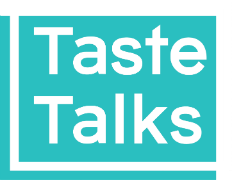Just a few short years ago, low-carb diets were all the rage. Thanks to famous fads like the high-protein Atkins plan and the now-defunct South Beach diet (which forbade simple carbs like white bread, white potatoes, and white rice), the prevailing notion was that carbohydrates were bad for you.
“They turn into sugar!” fitness gurus proclaimed, banning bread and pasta from the meals of millions. And so it was that bread became a dirty word, particularly in the trendy, faddish world of L.A. diets .
Yet recently, the tides have turned. Some may even say that L.A. bread culture is experiencing a true revival. Los Angeles—though it may seem to be, at first glance, inhospitable to carbs—is actually no stranger to bread. One of its oldest and most well-known bakeries, La Brea Bakery , was founded in 1989, and many breadmakers are now railing against ” carbophobia ,” debunking the notion that carbs, and by extension, bread, are inherently unhealthy.
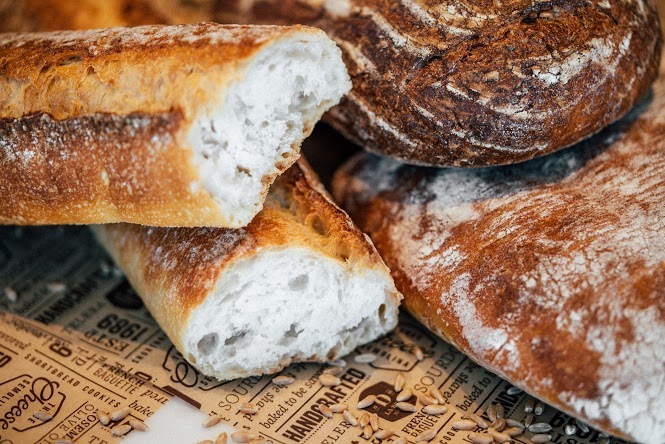 Some samplings of La Brea Bakery’s artisanal bread. Photo by Andrew Noel
Some samplings of La Brea Bakery’s artisanal bread. Photo by Andrew Noel
This might be an opportune moment to explain what a carbohydrate is, really. Carbs are the starches, fibers, and, yes, sugars, found in fruits, grains, vegetables and milk products. But far from the malicious fat-builders they’ve been portrayed as, the various forms of saccharides in carbs are necessary to give the body energy and nutrition. There are good carbs and bad carbs , with fruits, vegetables, and whole grains falling into the former category; refined grains and sugars with very little nutritional value fall into the latter.
In light of this, it’s easy to see how not all breads are created equal: when you eat a piece of artisanal bread baked with whole grains, it is an entirely different experience for your body than eating a slice of refined white bread. The whole grains break down slowly, secreting insulin and providing energy and other nutrients for the body, while refined grains, which have little to no nutritional value, are digested quickly, causing spikes of insulin and the requisite crash after a sugar rush.
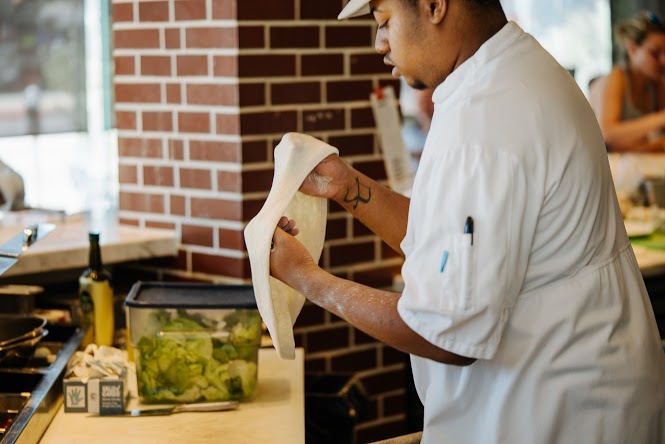 A baker at La Brea Bakery prepares some dough. Photo by Andrew Noel
A baker at La Brea Bakery prepares some dough. Photo by Andrew Noel
Across the country, m ore and more artisanal bakers are utilizing whole grains, simple ingredients, and farm-to-table processes to reinvent the bread industry , fitting it into the national conversation about healthier eating and sustainable agriculture . Whole grain brads have outsold soft white bread since 2010 , with wheat bread sales increasing 0.6 percent to $2.6 billion, while white bread sales declined 7 percent to $2.5 billion that year (the sales of whole grain breads have soared overall by a whopping 70% since 2005 ).
Childhood staples like sliced bread brand Sunbeam have also taken a hit , in favor of private labels like the all-natural brand Nature’s Own, which was the second ranked fresh bread brand of the United States last year, selling $838.7 million dollars in carbs in 2015. The first ranked bread-sellers, however, were independent and private labels, like the kind of bread bought from artisan bakeries, which raked in over $2 billion dollars worth of sales .
It seems the bread revolution isn’t just nutritious; it’s lucrative.
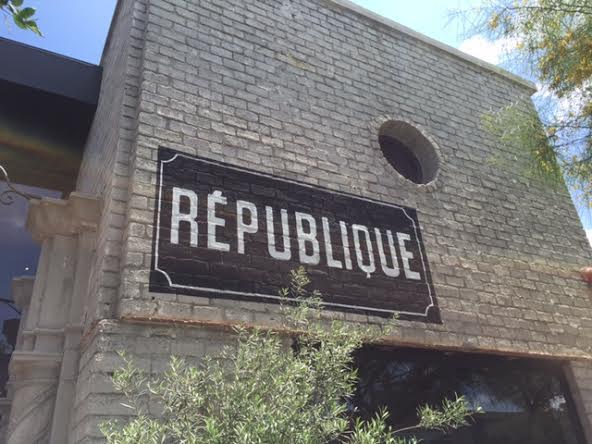 The exterior of Republique, a restaurant known for their loaves. Photo by Eboni Harris
The exterior of Republique, a restaurant known for their loaves. Photo by Eboni Harris
Republique , an airy restaurant and bakery on La Brea Avenue that opened in December 2013, wants to get their bread onto that list of best-selling independent and private labels. Co-owned and operated by husband-and-wife team Walter and Margarita Manzke, the duo opened the French eatery in a striking brick building only blocks from the famous La Brea Bakery (fun fact: their building was the original La Brea Bakery, before its owner, Nancy Silverton, decided to move it).
While running their first two restaurants in Carmel, Walter and Margarita quickly realized they were unable to find the kind of bread they wanted to serve. Supermarket brands were full of chemicals and preservatives, and they wanted quality bread that not only tasted delicious, but also utilized all-natural ingredients. So the Manzkes began to experiment with creating their own, using four simple ingredients: water, yeast, flour, and salt. After moving back to L.A. from Carmel, they found that not much was different with store offerings.
“There are a lot of up-and-coming bakeries,” explains Margarita, “but even though artisan bread is so big, with people wanting to eat better, right now the only good bread you can really buy in a supermarket is La Brea. But that’s going to change.”
She credits much of the success of Republique to the quality of their artisan breads, and hopes to one day grow the retail portion of their restaurant. Though the restaurant is known for its communal tables that offer an intimate dining experience, they’ve made their way onto several ” B est of L.A. ” bread lists due to their wildly popular multigrain bread and croissant donuts that sell over a thousand a day —on busy days, they’ll move as many as 300 an hour.
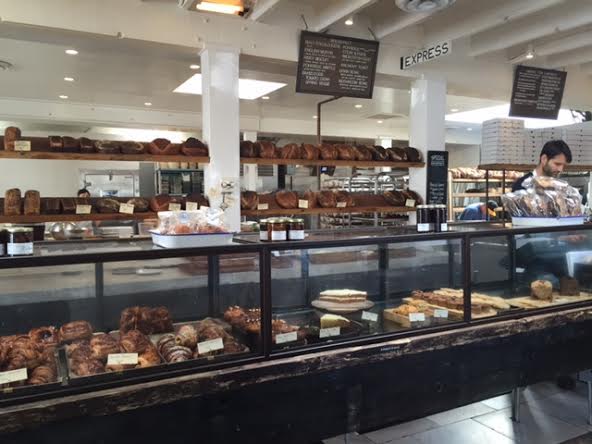 The carb-heavy counter at Gjusta. Photo by Eboni Harris
The carb-heavy counter at Gjusta. Photo by Eboni Harris
“Despite us not being known as a ‘bakery,’ we sell out of our baguettes every day!,” says Manzke. “We bake fresh every morning. Five years down the road, I would love to be able to sell loaves of bread out of Republique and have bread on the shelves of stores.”
Another L.A. bakery selling whole loaves to the hungry masses yearning to be free of pre-sliced white bread is Gjusta , a 5,000 square foot bakery and café in Venice. Run by Travis Lett and Fran Camaj, the duo behind hit pizza establishment Gjelina , Gjusta opened three years ago with the intent to provide really good bread. Although they serve the same kind of California Italian/ Mediterranean small plates that have made Gjelina so popular, the bread comes first at Gjusta. They offer 12 types of breads, from a sourdough country loaf to a fruit and nut rye morning bread, and 16 different pastries, including seasonal tartlettes. At 10 a.m. on a Monday morning, Gjusta is full of people ordering bread by the slice, by the breakfast sandwich, and by the loaf, walking out with their arms laden down with white paper packages. Certainly, no one here has a fear of carbs.
Gjusta does more than just sell bread, however: they also do volunteer and outreach programs ( as does Gjelina ), including a young chef partnership with Venice High School meant to teach kids how to make real bread, and see the difference between what they would buy in the store and what they can create themselves. There is a clear desire across the food space to teach where food comes from and what it should be. One of the main lessons they’re striving to impart seems to be that bread itself isn’t bad for you; bad bread is bad for you.
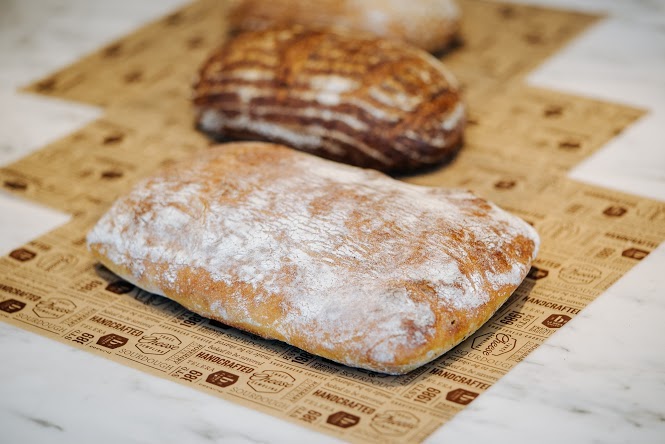 Bread on bread on bread. Photo by Andrew Noel
Bread on bread on bread. Photo by Andrew Noel
Andrew Blok, the brand manager at La Brea Bakery, echoes that sentiment.
“L.A. is a pressure cooker for all of these trends,” he said. “We’re early on the bandwagon and the first ones off. In an image-obsessed culture like L.A., carbs were a well-attacked premise, but it all comes back to education: people are discovering that ‘not all carbs were created equal’ and learning the benefits of a balanced diet using natural, whole grain solutions.”
Blok laments that, for a long time, whole grains were lumped into the same category as refined white sugar. He hopes that moving forward, people realize that it’s okay to eat bread, as long as consumers think about the types that they’re eating and the ingredients that went into it.
Blok worked in the wine industry for ten years before moving to La Brea, and has been part of a new initiative launched by the bakery called La Brea Bakery Reserve . The program seeks to link breads with a specific place, similarly to the way we think about wine, and has started by growing a strain of wheat in Montana to create bread with a distinct flavor, notes, and texture. The three separate loaves being created, called Pain de Campagne, Fortuna Wheat Loaf, and Struan, are baked using ingredients sourced exclusively from Wheat Montana Farms in Three Forks, Montana.
Blok believes that bakeries like La Brea are pushing for the return to craft and understanding where our bread comes from. He thinks bread can regain it’s place in a healthy eating movement that has generally pushed the importance of fruits and vegetables but tends to forget about bread.
“It was our first recipe; the first thing that man put together,” he said. “But we’ve lost sight of that even as we’ve had more conversations around food, nutrition, and eating. Right now, people go to farmers markets every week for fresh fruits and vegetables; I think that’s going to continue with bread.”
Want more fresh-out-of-the-oven L.A. food trends? Secure your front row seat to the future of taste and buy your ticket to Taste Talks Los Angeles today!







